Complete Mitochondrial Genome, Genetic Diversity and Phylogenetic Analysis of Pingpu Yellow Chicken (Gallus gallus)
Abstract
Simple Summary
Abstract
1. Introduction
2. Materials and Methods
2.1. Ethics Statement
2.2. Specimen Collection and DNA Extraction
2.3. PCR Amplification and DNA Sequencing of D-Loop
2.4. Next-Generation Sequencing of the Mitogenome
2.5. Data Analysis
3. Results
3.1. The Analysis of Complete mtDNA
3.2. Codon Usage and PCGs
3.3. Transfer and Ribosomal RNA Genes of PYC
3.4. Structural Features and Sequence Composition of the Full-Length mtDNA D-Loop
3.5. Phylogenetic Reconstructions Based on Complete mtDNA
4. Discussion
5. Conclusions
Author Contributions
Funding
Institutional Review Board Statement
Informed Consent Statement
Data Availability Statement
Acknowledgments
Conflicts of Interest
References
- Kuznetsova, M.V.; Kholodova, M.V.; Lushchekina, A.A. Phylogenetic analysis of sequences of the 12S and 16S rRNA mitochondrial genes in the family Bovidae: New evidence. Genetika 2002, 38, 1115–1124. [Google Scholar]
- Webb, D.M.; Moore, W.S. A phylogenetic analysis of woodpeckers and their allies using 12S, Cyt b, and COI nucleotide sequences (class Aves; order Piciformes). Mol. Phylogenet. Evol. 2005, 36, 233–248. [Google Scholar] [CrossRef] [PubMed]
- Kanginakudru, S.; Metta, M.; Jakati, R.D.; Nagaraju, J. Genetic evidence from Indian red jungle fowl corroborates multiple domestication of modern day chicken. BMC Evol. Biol. 2008, 8, 174. [Google Scholar] [CrossRef] [PubMed]
- Oka, T.; Ino, Y.; Nomura, K.; Kawashima, S.; Kuwayama, T.; Hanada, H.; Amano, T.; Takada, M.; Takahata, N.; Hayashi, Y.; et al. Analysis of mtDNA sequences shows Japanese native chickens have multiple origins. Anim. Genet. 2007, 38, 287–293. [Google Scholar] [CrossRef] [PubMed]
- Silva, P.; Guan, X.; Ho-Shing, O.; Jones, J.; Xu, J.; Hui, D.; Notter, D.; Smith, E. Mitochondrial DNA-based analysis of genetic variation and relatedness among Sri Lankan indigenous chickens and the Ceylon junglefowl (Gallus lafayetti). Anim. Genet. 2009, 40, 1–9. [Google Scholar] [CrossRef] [PubMed]
- Halima, H.; Neser, F.W.; Van Marle-Koster, E.; De Kock, A. Village-based indigenous chicken production system in north-west Ethiopia. Trop. Anim. Health Prod. 2007, 39, 189–197. [Google Scholar] [CrossRef] [PubMed]
- Mwacharo, J.M.; Bjornstad, G.; Mobegi, V.; Nomura, K.; Hanada, H.; Amano, T.; Jianlin, H.; Hanotte, O. Mitochondrial DNA reveals multiple introductions of domestic chicken in East Africa. Mol. Phylogenet. Evol. 2011, 58, 374–382. [Google Scholar] [CrossRef]
- Fumihito, A.; Miyake, T.; Takada, M.; Shingu, R.; Endo, T.; Gojobori, T.; Kondo, N.; Ohno, S. Monophyletic origin and unique dispersal patterns of domestic fowls. Proc. Natl. Acad. Sci. USA 1996, 93, 6792–6795. [Google Scholar] [CrossRef]
- Vaisanen, J.; Hakansson, J.; Jensen, P. Social interactions in Red Junglefowl (Gallus gallus) and White Leghorn layers in stable groups and after re-grouping. Br. Poult. Sci. 2005, 46, 156–168. [Google Scholar] [CrossRef]
- Gao, Y.S.; Jia, X.X.; Tang, X.J.; Fan, Y.F.; Lu, J.X.; Huang, S.H.; Tang, M.J. The genetic diversity of chicken breeds from Jiangxi, assessed with BCDO2 and the complete mitochondrial DNA D-loop region. PLoS ONE 2017, 12, e0173192. [Google Scholar]
- Zhang, T.; Liu, H.; Yang, L.K.; Yin, Y.J.; Lu, H.Z.; Wang, L. The complete mitochondrial genome and molecular phylogeny of Lueyang black-bone chicken. Br. Poult. Sci. 2018, 59, 618–623. [Google Scholar] [CrossRef] [PubMed]
- Boudali, S.F.; Al-Jumaili, A.S.; Bouandas, A.; Mahammi, F.Z.; Tabet Aoul, N.; Hanotte, O.; Gaouar, S.B.S. Maternal origin and genetic diversity of Algerian domestic chicken (Gallus gallus domesticus) from North-Western Africa based on mitochondrial DNA analysis. Anim. Biotechnol. 2022, 33, 457–467. [Google Scholar] [CrossRef] [PubMed]
- Fu, D.; Ma, X.; Jia, C.; Lei, Q.; Wu, X.; Chu, M.; Ding, X.; Bao, P.; Pei, J.; Guo, X.; et al. Characterization of the complete mitochondrial genome sequence of Jialuo sheep (Ovis aries). Mitochondrial DNA B Resour. 2019, 4, 2116–2117. [Google Scholar] [CrossRef] [PubMed]
- Qiao, G.; Zhang, H.; Zhu, S.; Yuan, C.; Zhao, H.; Han, M.; Yue, Y.; Yang, B. The complete mitochondrial genome sequence and phylogenetic analysis of Alpine Merino sheep (Ovis aries). Mitochondrial DNA B Resour. 2020, 5, 990–991. [Google Scholar] [CrossRef] [PubMed]
- Pramod, R.K.; Velayutham, D.; Sajesh, P.K.; Beena, P.S.; Zachariah, A.; Zachariah, A.; Chandramohan, B.; Sujith, S.S.; Ganapathi, P.; Dhinoth Kumar, B.; et al. Complete mitogenome reveals genetic divergence and phylogenetic relationships among Indian cattle (Bos indicus) breeds. Anim. Biotechnol. 2019, 30, 219–232. [Google Scholar] [CrossRef]
- Xia, X.; Qu, K.; Zhang, G.; Jia, Y.; Ma, Z.; Zhao, X.; Huang, Y.; Chen, H.; Huang, B.; Lei, C. Comprehensive analysis of the mitochondrial DNA diversity in Chinese cattle. Anim. Genet. 2019, 50, 70–73. [Google Scholar] [CrossRef]
- Rychlik, W. OLIGO 7 primer analysis software. Methods Mol. Biol. 2007, 402, 35–60. [Google Scholar]
- Stephan, G.; Pascal, L.; Ralph, B. Organellar Genome DRAW (OGDRAW) version 1.3.1: Expanded toolkit for the graphical visualization oforganellar genomes. Nucleic Acids Res. 2019, 47, W59–W64. [Google Scholar]
- Kumar, S.; Stecher, G.; Tamura, K. MEGA7: Molecular evolutionary genetics analysis version 7.0 for bigger datasets. Mol. Biol. Evol. 2016, 33, 1870–1874. [Google Scholar] [CrossRef]
- Perna, N.T.; Kocher, T.D. Patterns of nucleotide composition at fourfold degenerate sites of animal mitochondrial genomes. J. Mol. Evol. 1995, 41, 353–358. [Google Scholar] [CrossRef]
- Chan, P.P.; Lowe, T.M. tRNAscan-SE: Searching for tRNA genes in genomic sequences. In Gene Prediction; Methods in Molecular Biology; Springer: Berlin/Heidelberg, Germany, 2019; Volume 1962, pp. 1–14. [Google Scholar]
- Saitou, N.; Nei, M. The neighbor-joining method: A new method for reconstructing phylogenetic trees. Mol. Biol. Evol. 1987, 4, 406–425. [Google Scholar] [PubMed]
- Kimura, M. A simple method for estimating evolutionary rates of base substitutions through comparative studies of nucleotide sequences. J. Mol. Evol. 1980, 16, 111–120. [Google Scholar] [CrossRef] [PubMed]
- Li, G.Q.; Moriyama, E.N. Vector NTI, a balanced all-in-one sequence analysis suite. Brief Bioinform. 2004, 5, 378–388. [Google Scholar]
- Larkin, M.A.; Blackshields, G.; Brown, N.P.; Chenna, R.; McGettigan, P.A.; McWilliam, H.; Valentin, F.; Wallace, I.M.; Wilm, A.; Lopez, R.; et al. Clustal W and Clustal X version 2.0. Bioinformatics 2007, 23, 2947–2948. [Google Scholar] [CrossRef]
- Rozas, J.; Ferrer-Mata, A.; Sanchez-DelBarrio, J.C.; Guirao-Rico, S.; Librado, P.; Ramos-Onsins, S.E.; Sanchez-Gracia, A. DnaSP 6: DNA sequence polymorphism analysis of large data sets. Mol. Biol. Evol. 2017, 34, 3299–3302. [Google Scholar] [CrossRef]
- Liu, Y.P.; Wu, G.S.; Yao, Y.G.; Miao, Y.W.; Luikart, G.; Baig, M.; Beja-Pereira, A.; Ding, Z.L.; Palanichamy, M.G.; Zhang, Y.P. Multiple maternal origins of chickens: Out of the Asian jungles. Mol. Phylogenet. Evol. 2006, 38, 12–19. [Google Scholar] [CrossRef]
- Miao, Y.W.; Peng, M.S.; Wu, G.S.; Ouyang, Y.N.; Yang, Z.Y.; Yu, N.; Liang, J.P.; Pianchou, G.; Beja-Pereira, A.; Mitra, B.; et al. Chicken domestication: An updated perspective based on mitochondrial genomes. Heredity 2013, 110, 277–282. [Google Scholar] [CrossRef]
- Lansman, R.A.; Avise, J.C.; Huettel, M.D. Critical experimental test of the possibility of “paternal leakage” of mitochondrial DNA. Proc. Natl. Acad. Sci. USA 1983, 80, 1969–1971. [Google Scholar] [CrossRef]
- Brown, W.M.; George, M., Jr.; Wilson, A.C. Rapid evolution of animal mitochondrial DNA. Proc. Natl. Acad. Sci. USA 1979, 76, 1967–1971. [Google Scholar] [CrossRef]
- Wenink, P.W.; Baker, A.J.; Tilanus, M.G. Mitochondrial control-region sequences in two shorebird species, the turnstone and the dunlin, and their utility in population genetic studies. Mol. Biol. Evol. 1994, 11, 22–31. [Google Scholar]
- Saccone, C.; Pesole, G.; Sbisa, E. The main regulatory region of mammalian mitochondrial DNA: Structure-function model and evolutionary pattern. J. Mol. Evol. 1991, 33, 83–91. [Google Scholar] [CrossRef] [PubMed]
- Southern, S.O.; Southern, P.J.; Dizon, A.E. Molecular characterization of a cloned dolphin mitochondrial genome. J. Mol. Evol. 1988, 28, 32–42. [Google Scholar] [CrossRef] [PubMed]
- Gu, J.; Li, S. The complete mitochondrial genome of the Luhua chicken (Gallus gallus). Mitochondrial DNA B Resour. 2020, 5, 2832–2834. [Google Scholar] [CrossRef]
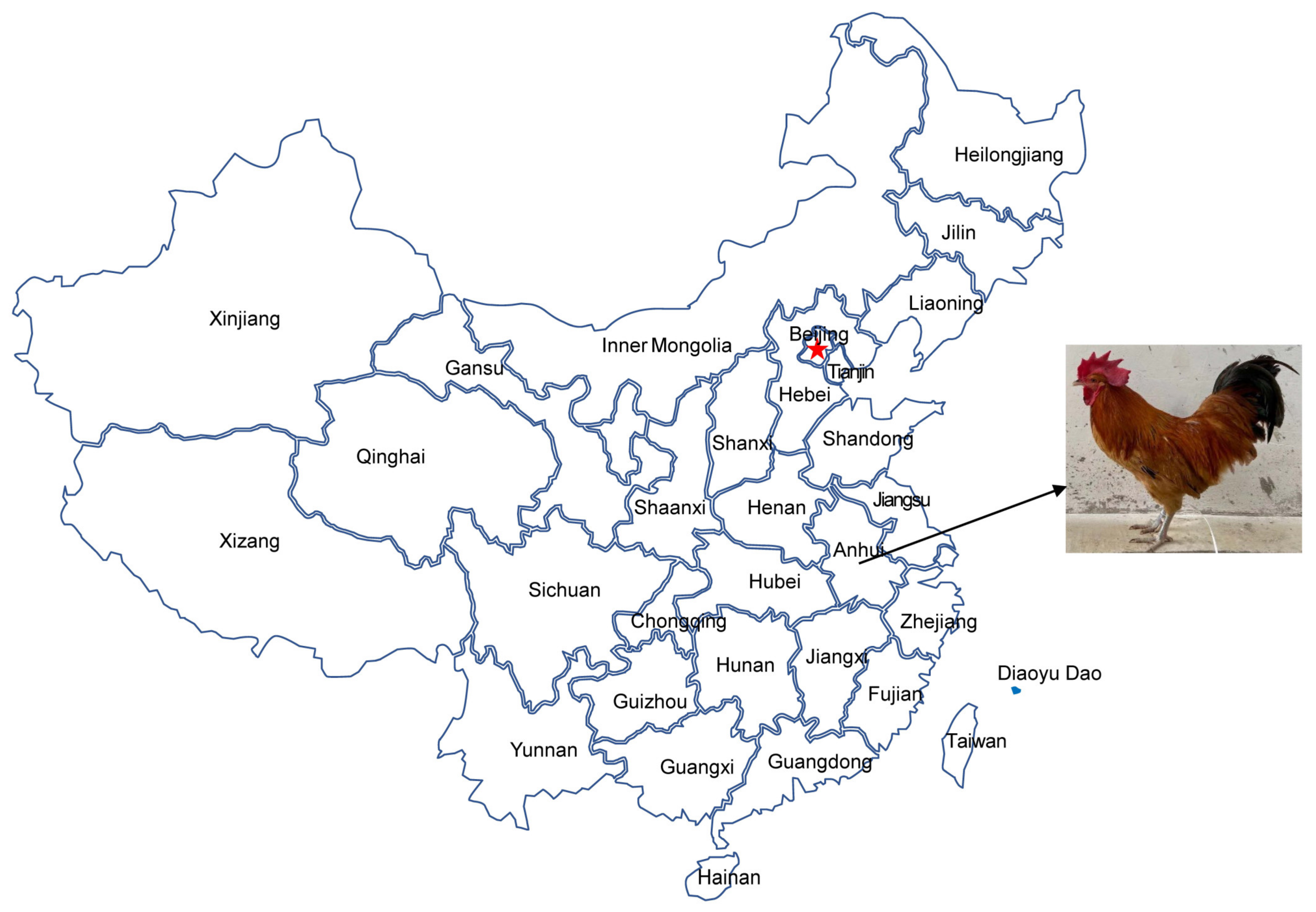
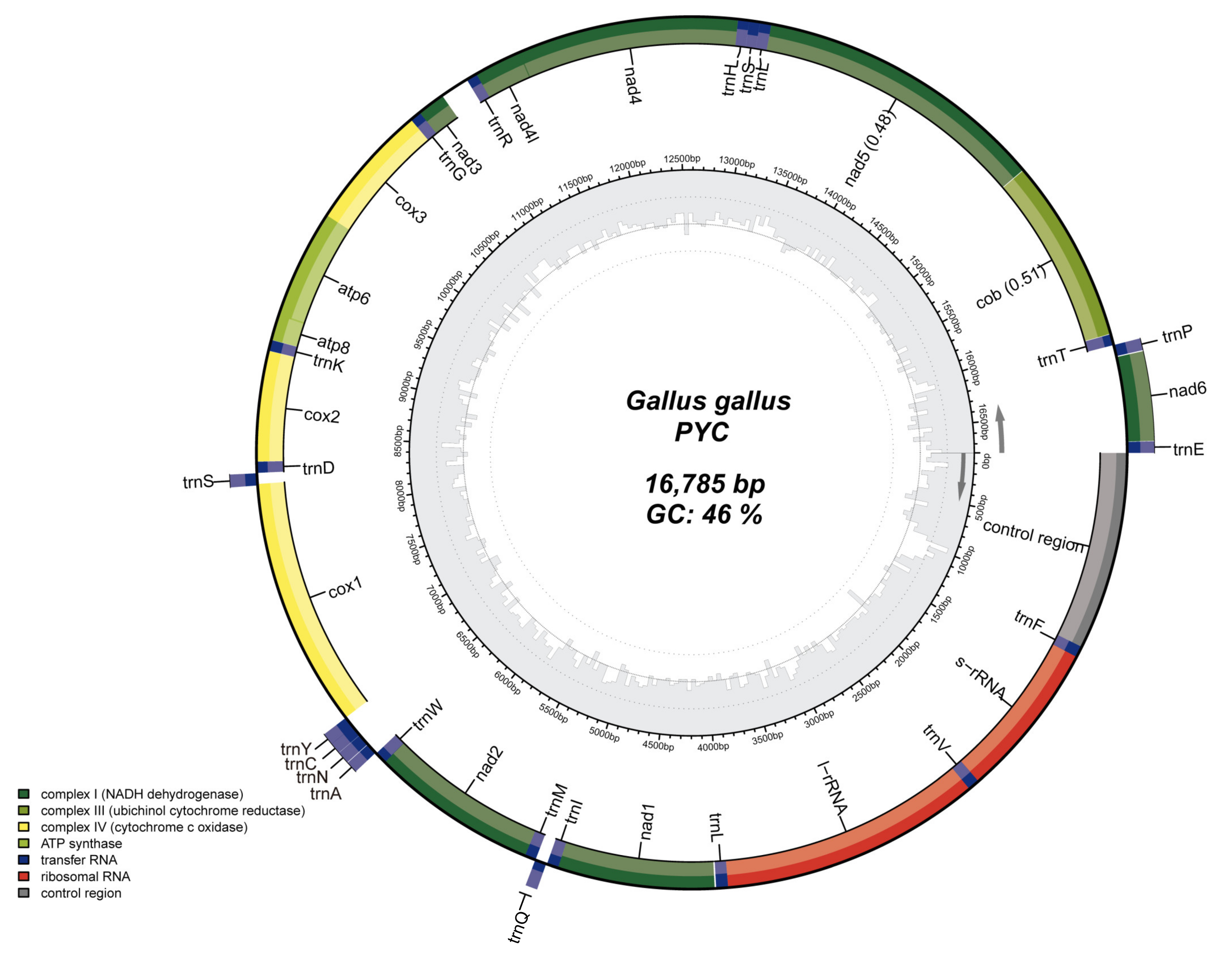
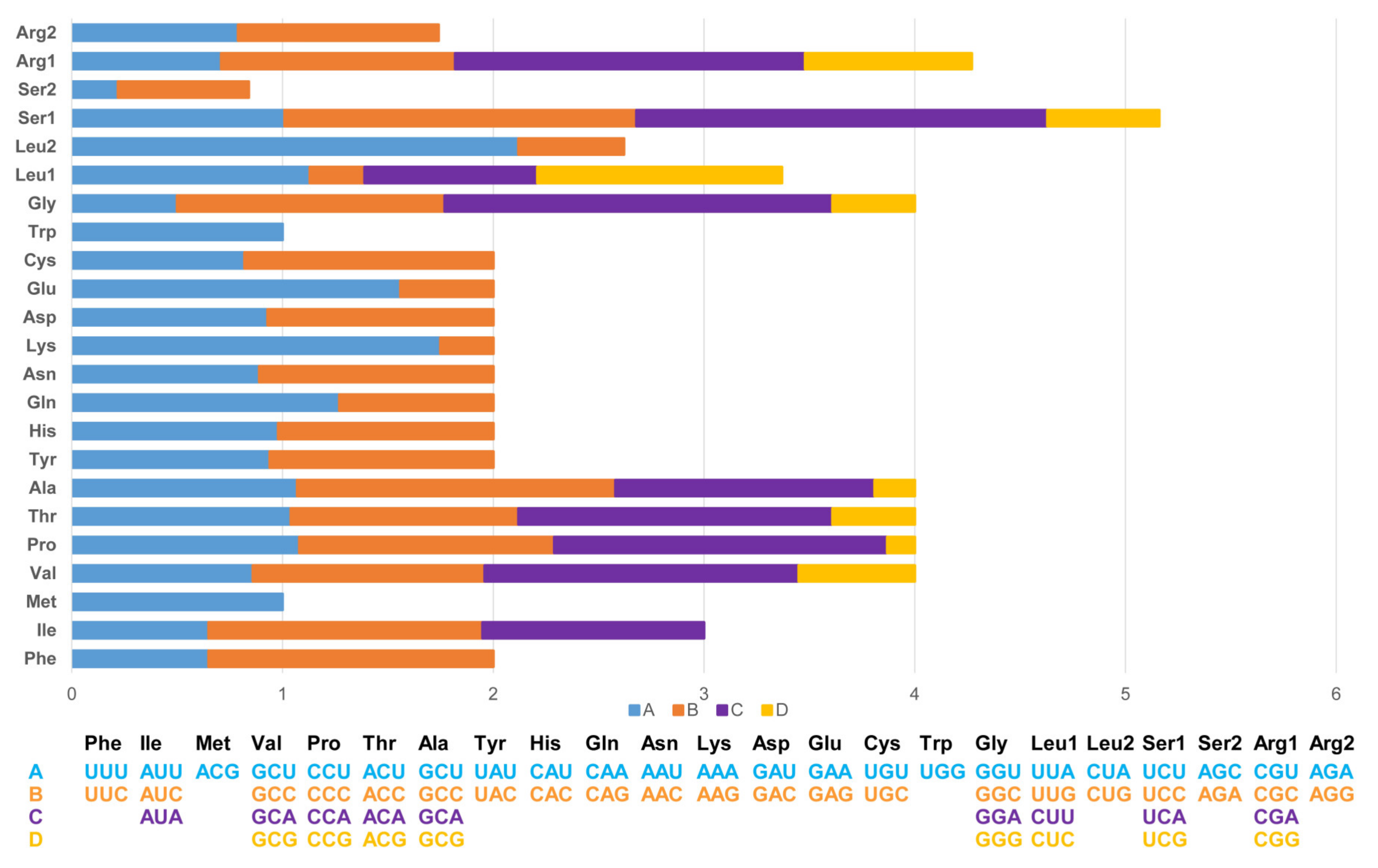
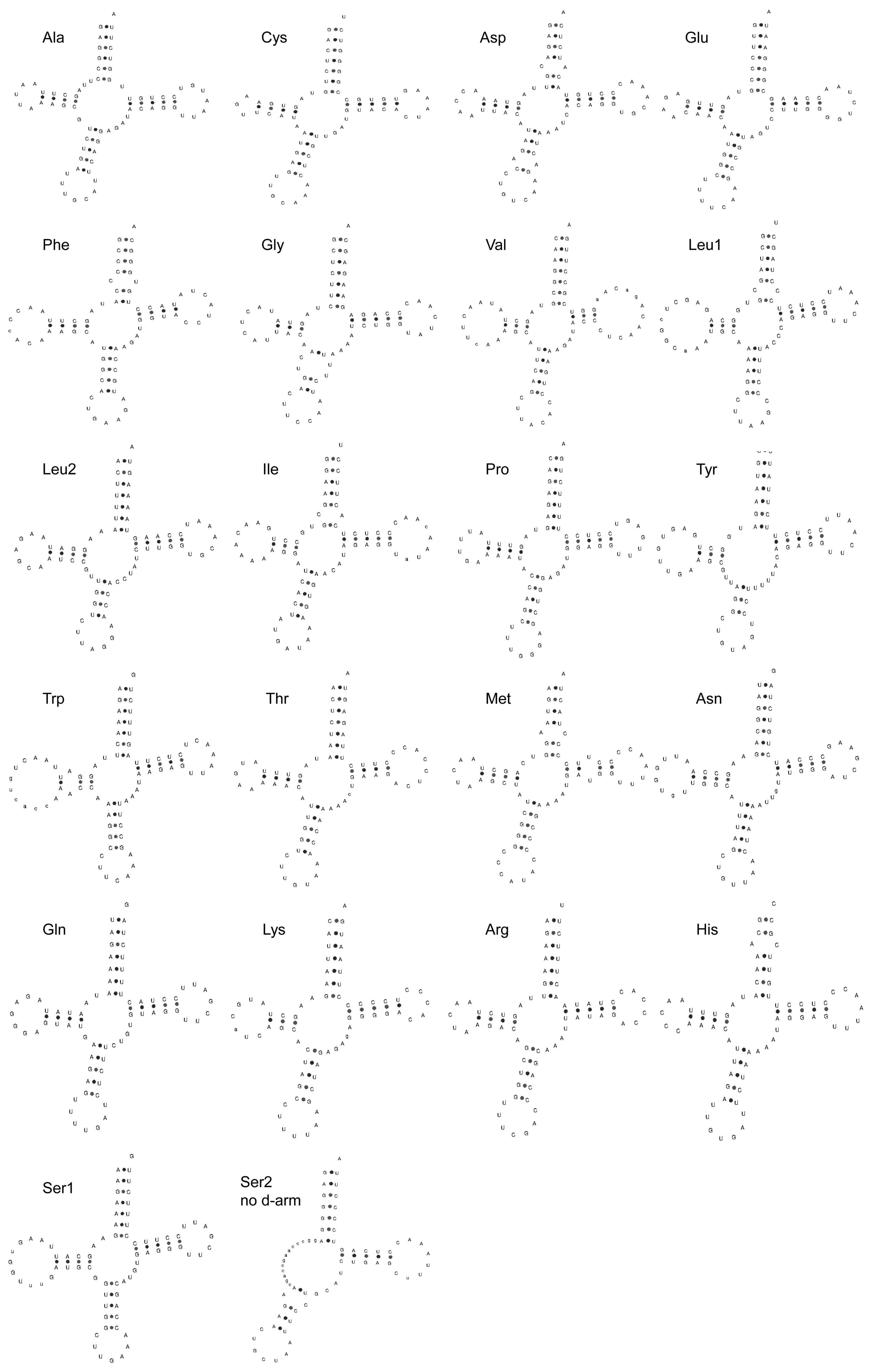
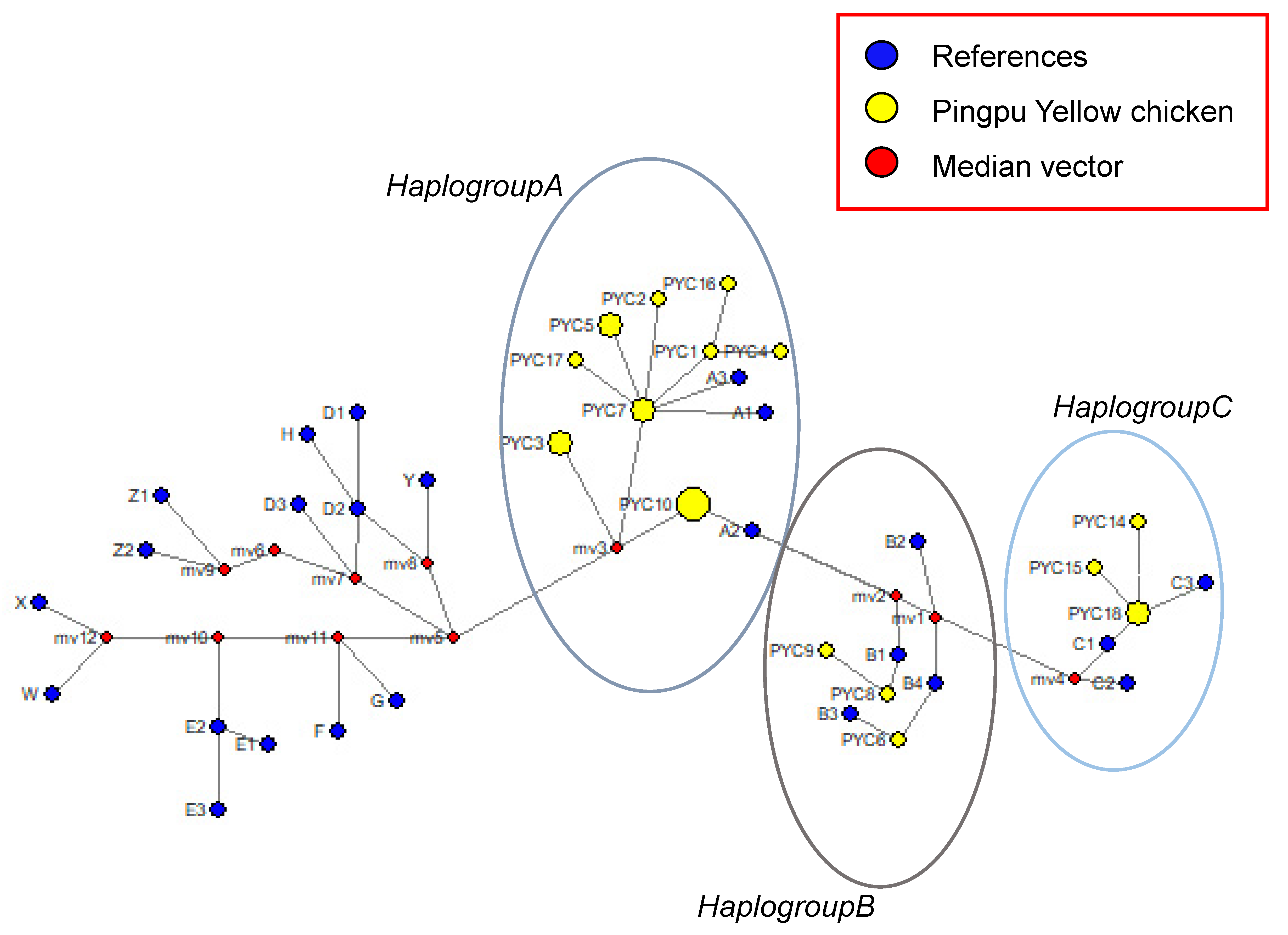
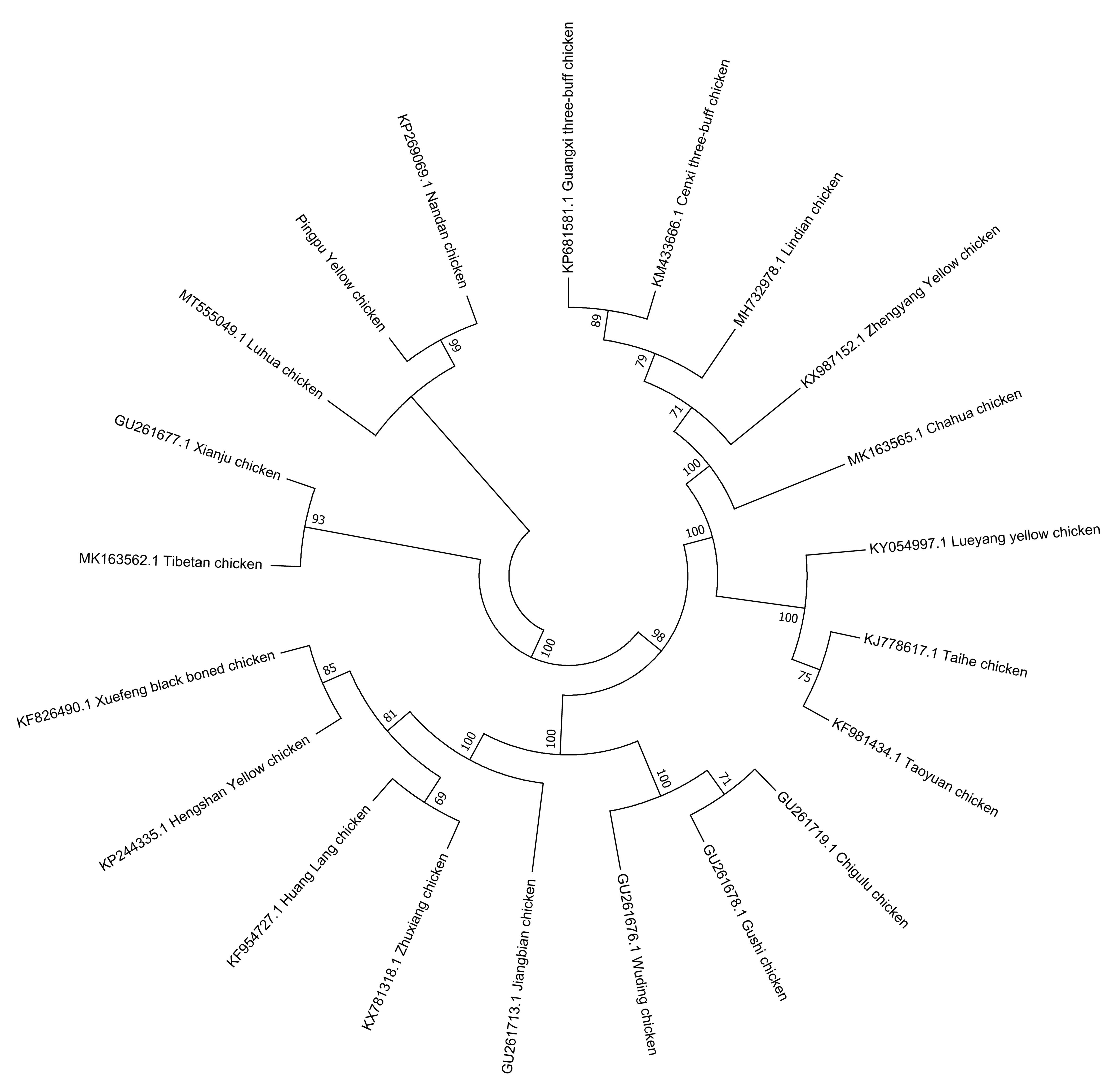
| Gene Name | Start and Stop | Length/bp | Strand | Anticodon | Start/Stop Codon |
|---|---|---|---|---|---|
| D-loop | 1~1231 | 1231 | + | - | - |
| tRNA-Phe | 1232~1301 | 70 | + | GAA | - |
| s-rRNA | 1301~2277 | 977 | + | - | - |
| tRNA-Val | 2277~2349 | 73 | + | TAC | - |
| l-rRNA | 2350~3972 | 1623 | + | - | - |
| tRNA-Leu | 3973~4046 | 74 | + | TAA | - |
| ND1 | 4056~5030 | 975 | + | - | ATG/TAA |
| tRNA-Ile | 5031~5102 | 72 | + | GAT | - |
| tRNA-Gln | 5108~5178 | 71 | - | TTG | - |
| tRNA-Met | 5178~5246 | 69 | + | CAT | - |
| ND2 | 5247~6287 | 1041 | + | - | ATG/TAG |
| tRNA-Trp | 6286~6361 | 76 | + | TCA | - |
| tRNA-Ala | 6368~6436 | 69 | - | TGC | - |
| tRNA-Asn | 6440~6512 | 73 | - | GTT | - |
| tRNA-Cys | 6514~6579 | 66 | - | GCA | - |
| tRNA-Tyr | 6579~6649 | 71 | - | GTA | - |
| COX1 | 6651~8201 | 1551 | + | - | GTG/AGG |
| tRNA-Ser | 8193~8267 | 75 | - | TGA | - |
| tRNA-Asp | 8270~8338 | 69 | + | GTC | - |
| COX2 | 8340~9023 | 684 | + | - | ATG/TAA |
| tRNA-Lys | 9025~9092 | 68 | + | TTT | - |
| ATP8 | 9094~9258 | 165 | + | - | ATG/TAA |
| ATP6 | 9249~9932 | 684 | + | - | ATG/TAA |
| COX3 | 9932~10715 | 784 | + | - | ATG/AGA |
| tRNA-Gly | 10716~10784 | 69 | + | TCC | - |
| ND3 | 10785~11136 | 351 | + | - | ATG/TAA |
| tRNA-Arg | 11138~11205 | 68 | + | TCG | - |
| ND4L | 11206~11502 | 297 | + | - | ATG/TAA |
| ND4 | 11496~12873 | 1378 | + | - | ATG/AGG |
| tRNA-His | 12874~12942 | 69 | + | GTG | - |
| tRNA-Ser | 12943~13009 | 67 | + | GCT | - |
| tRNA-Leu | 13010~13080 | 71 | + | TAG | - |
| ND5 | 13081~14898 | 1818 | + | - | ATG/TAA |
| CYTB | 14903~16045 | 1143 | + | - | ATG/TAA |
| tRNA-Thr | 16049~16117 | 69 | + | TGT | - |
| tRNA-Pro | 16118~16187 | 70 | - | TGG | - |
| ND6 | 16194~16715 | 522 | - | - | ATG/TAA |
| tRNA-Glu | 16718~16785 | 1216 | - | TTC | - |
| Item | Length(bp) | A% | T% | G% | C% | AT% | GC% | AT-Skew | GC-Skew |
|---|---|---|---|---|---|---|---|---|---|
| Complete mitogenome | 16,785 | 30.3 | 23.7 | 13.5 | 32.5 | 54.0 | 46.0 | 0.1222 | −0.4130 |
| PCGs | 11,394 | 29.7 | 23.3 | 12.0 | 35.0 | 53.0 | 47.0 | 0.1208 | −0.4894 |
| tRNAs | 1547 | 32.8 | 24.6 | 17.1 | 25.5 | 57.4 | 42.6 | 0.1429 | −0.1972 |
| rRNAs | 2600 | 33.0 | 20.4 | 18.2 | 28.4 | 53.4 | 46.6 | 0.2360 | −0.2189 |
| Control region | 1231 | 26.6 | 33.5 | 13.4 | 26.6 | 60.1 | 40.0 | −0.1148 | −0.3300 |
| Haplotypes | Haplogroup | Localization of Polymorphic Sites | ||||||||||||||||||||||||
|---|---|---|---|---|---|---|---|---|---|---|---|---|---|---|---|---|---|---|---|---|---|---|---|---|---|---|
| 167 | 212 | 219 | 223 | 225 | 242 | 243 | 246 | 256 | 281 | 296 | 298 | 310 | 315 | 342 | 361 | 363 | 367 | 391 | 396 | 686 | 711 | 792 | 863 | 1251 | ||
| GU261704.1 | T | A | C | C | C | G | T | T | T | A | T | C | C | T | A | A | C | T | C | T | G | G | G | A | A | |
| PYC-1 | B | * | * | * | T | * | * | * | * | * | * | C | * | * | * | * | * | * | * | * | * | * | * | * | * | * |
| PYC-2 | A | C | G | * | T | T | * | * | C | * | * | C | * | * | C | * | * | * | C | * | * | * | * | * | * | G |
| PYC-3 | C | C | G | * | T | T | * | * | C | C | * | C | * | * | C | * | * | * | * | A | * | * | * | * | * | G |
| PYC-4 | B | * | * | * | T | * | * | * | * | * | * | C | * | * | * | * | * | * | * | * | * | * | * | * | T | * |
| PYC-5 | A | C | G | * | T | T | * | * | C | * | * | C | * | * | C | * | * | * | * | * | C | * | * | * | * | G |
| PYC-6 | B | * | * | * | T | * | * | * | * | * | * | C | * | * | * | * | * | * | * | * | * | * | * | A | * | * |
| PYC-7 | A | C | G | * | T | T | * | * | C | * | * | C | * | * | C | * | * | * | * | * | * | * | * | * | * | G |
| PYC-8 | C | * | * | * | T | * | A | C | C | C | G | C | * | T | C | * | * | T | C | * | * | * | * | * | * | * |
| PYC-9 | C | * | * | * | * | * | A | C | C | C | G | C | * | T | C | * | * | T | C | * | * | * | * | * | * | G |
| PYC-10 | C | * | G | * | T | * | A | C | C | C | G | C | * | T | C | G | * | T | C | * | * | A | * | * | * | G |
| PYC-11 | C | * | G | * | T | * | A | C | C | C | G | C | * | T | C | G | * | T | C | * | * | * | A | * | * | G |
| PYC-12 | B | * | * | * | T | * | * | * | * | * | * | C | T | * | * | * | * | * | * | * | * | * | * | * | * | * |
| PYC-13 | A | C | G | * | T | T | * | * | C | * | * | C | * | * | C | * | * | * | * | * | * | A | * | * | * | G |
| PYC-14 | D | * | G | * | T | * | A | C | C | C | G | C | * | T | C | G | * | T | C | * | * | * | * | * | * | G |
| PYC-15 | A | C | G | T | T | T | * | * | C | * | * | C | * | * | C | * | * | * | * | * | * | * | * | * | * | G |
| PYC-16 | C | * | G | * | T | * | A | C | C | C | G | C | * | T | C | G | * | T | C | T | * | * | * | * | * | * |
| PYC-17 | A | C | G | * | T | T | * | * | C | * | * | C | * | * | C | * | T | * | * | * | * | * | * | * | * | G |
| PYC-18 | C | * | * | * | T | * | A | C | C | C | G | C | * | T | C | G | * | T | C | * | * | * | * | * | * | * |
Publisher’s Note: MDPI stays neutral with regard to jurisdictional claims in published maps and institutional affiliations. |
© 2022 by the authors. Licensee MDPI, Basel, Switzerland. This article is an open access article distributed under the terms and conditions of the Creative Commons Attribution (CC BY) license (https://creativecommons.org/licenses/by/4.0/).
Share and Cite
Jin, S.; Xia, J.; Jia, F.; Jiang, L.; Wang, X.; Liu, X.; Liu, X.; Geng, Z. Complete Mitochondrial Genome, Genetic Diversity and Phylogenetic Analysis of Pingpu Yellow Chicken (Gallus gallus). Animals 2022, 12, 3037. https://doi.org/10.3390/ani12213037
Jin S, Xia J, Jia F, Jiang L, Wang X, Liu X, Liu X, Geng Z. Complete Mitochondrial Genome, Genetic Diversity and Phylogenetic Analysis of Pingpu Yellow Chicken (Gallus gallus). Animals. 2022; 12(21):3037. https://doi.org/10.3390/ani12213037
Chicago/Turabian StyleJin, Sihua, Jingjing Xia, Fumin Jia, Lijun Jiang, Xin Wang, Xuling Liu, Xing Liu, and Zhaoyu Geng. 2022. "Complete Mitochondrial Genome, Genetic Diversity and Phylogenetic Analysis of Pingpu Yellow Chicken (Gallus gallus)" Animals 12, no. 21: 3037. https://doi.org/10.3390/ani12213037
APA StyleJin, S., Xia, J., Jia, F., Jiang, L., Wang, X., Liu, X., Liu, X., & Geng, Z. (2022). Complete Mitochondrial Genome, Genetic Diversity and Phylogenetic Analysis of Pingpu Yellow Chicken (Gallus gallus). Animals, 12(21), 3037. https://doi.org/10.3390/ani12213037




